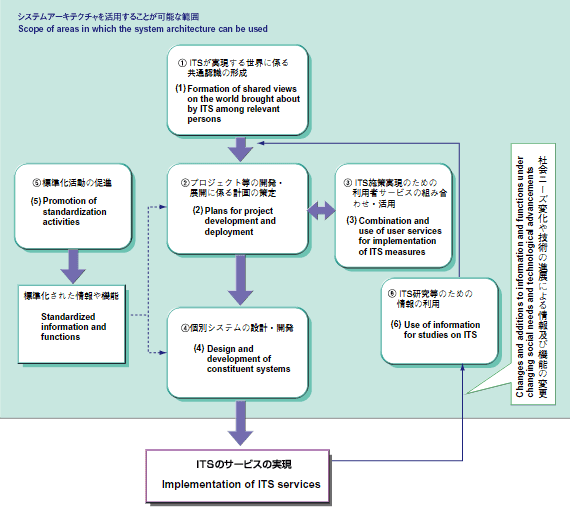 Trends in the system architecture development in Europe and the U.S.
Trends in the system architecture development in Europe and the U.S.
 Trends in the system architecture development in Europe and the U.S.
Trends in the system architecture development in Europe and the U.S.
 Uses of the system architecture
Uses of the system architecture
(1) Formation of shared views on the world brought about by ITS among relevant persons
Through the use of ITS services and a system architecture which clarifies the overall ITS scheme, shared views on the world with ITS can be formed among relevant persons, thus enabling cooperation and an appropriate role allocation among them.
(2) Plans for project development and deployment
By clarifying the scope of projects to be undertaken based on the entire physical model of the system architecture, related information and functions can be identified systematically. It further enables systematic and specific studies on technological methods, standards, and organizations, thus allowing efficient development and deployment of projects.
(3) Combination and use of user services for implementation of ITS measures
If some of the user services described systematically in the system architecture are combined, they can be used for comprehensive measures such as traffic demand management. It will enhance the effects of comprehensive measures encompassing various fields, and contribute to the reduction of traffic congestion and environmental burdens.
(4) Design and development of constituent systems
Information and functions whose relationships have already been defined in the system architecture can be used as a framework for design and development of constituent systems. Through such a process, many steps may be short-cut. It allows easy identification of functions shared with other constituent systems, which in turn will enhance design and development efficiency for the constituent systems.
(5) Promotion of standardization activities
In the system architecture, standardization candidate areas have been clarified for the whole ITS scheme, and subsystems and communication links which are deemed as important for system configuration have been identified as areas especially requiring standardization. As such, the system architecture can promote effective standardization activities.
(6) Use of information for studies on ITS
If constituent systems are developed in accordance with the physical architecture, the constituent systems containing data necessary for research and analysis to be performed can be easily identified. Thus, it will facilitate reflection of social demands onto plans, designs, and development of the ITS services.
|
